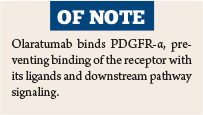In the Clinic provides overviews of novel oncology agents, addressing indications, mechanisms, administration recommendations, safety profiles, and other essential information needed for the appropriate clinical use of these drugs.
On October 19, 2016, the platelet-derived growth factor receptor alpha (PDGFR-α)-blocking antibody olaratumab (Lartruvo) was granted accelerated approval in combination with doxorubicin for the treatment of soft-tissue sarcoma not amenable to curative treatment with radiotherapy or surgery and with a histologic subtype for which an anthracycline-containing regimen is appropriate.1,2
Supporting Efficacy Data
Approval was based on data from a U.S. phase II trial in which 133 patients were randomly assigned to receive the combination of olaratumab plus doxorubicin (n = 66) or doxorubicin alone (n = 67).2,3 Olaratumab was given at 15 mg/kg via intravenous (IV) infusion on days 1 and 8 of each 21-day cycle; doxorubicin was given at 75 mg/m2 on day 1 of each 21-day cycle for a maximum of 8 cycles with dexrazoxane permitted in cycles 5 to 8.
All patients had soft-tissue sarcoma not amenable to curative treatment with surgery or radiotherapy and a histologic type of sarcoma for which an anthracycline-containing regimen was appropriate but had not been administered. Olaratumab was offered to patients in the doxorubicin group at disease progression.
New Agent for Soft-Tissue Sarcoma
- Olaratumab (Lartruvo) was approved in combination with doxorubicin for the treatment of soft-tissue sarcoma not amenable to curative treatment with radiotherapy or surgery and with a histologic subtype for which an anthracycline-containing regimen is appropriate.
- The recommended dose of olaratumab is 15 mg/kg as an IV infusion over 60 minutes on days 1 and 8 of each 21-day cycle until disease progression or unacceptable toxicity.
All patients had metastatic disease; median age was 58 years (range = 22–86 years); 45% were male; 87% were white; Eastern Cooperative Oncology Group performance status was 0 for 57%, 1 for 39%, and 2 for 5%; 65% had received no prior chemotherapy (excluding adjuvant and neoadjuvant therapies); 38% had leiomyosarcoma, 1.5% had synovial sarcoma, and 61% had other histologies (> 25 different histologies).
Median overall survival was 26.5 months (95% confidence interval [CI] = 20.9–31.7 months) in the combination group vs 14.7 months (95% CI = 9.2–17.1 months) in the doxorubicin-alone group (hazard ratio [HR] = 0.52, 95% CI = 0.34–0.79, P < .05). Median progression-free survival was 8.2 vs 4.4 months (HR = 0.74, 95% CI = 0.46–1.19). The overall response rate was 18% vs 8%.
How It Works
Olaratumab is a human IgG1 antibody that binds PDGFR-α, a receptor tyrosine kinase expressed on cells of mesenchymal origin. Signaling through this receptor plays a role in cell growth, chemotaxis, and mesenchymal stem cell differentiation. The receptor is also found on some tumor and stromal cells, including sarcomas, with signaling contributing to cancer cell proliferation, metastasis, and maintenance of the tumor microenvironment.
The interaction of olaratumab with PDGFR-α prevents binding of the receptor with PDGF-AA and -BB ligands and prevents PDGF-AA, -BB, and ‑CC–induced receptor activation and downstream PDGFR-α pathway signaling. Olaratumab exhibits in vitro and in vivo antitumor activity against selected sarcoma cell lines and disrupts the PDGFR-α signaling pathway in in vivo tumor implant models.
How It Is Used
The recommended dose of olaratumab is 15 mg/kg as an IV infusion over 60 minutes on days 1 and 8 of each 21-day cycle until disease progression or unacceptable toxicity. For the first eight cycles, olaratumab is given with doxorubicin. Patients should be premedicated with diphenhydramine (25–50 mg IV) and dexamethasone (10–20 mg IV) prior to olaratumab on day 1 of cycle 1.

Olaratumab infusion should be interrupted for grade 1 or 2 infusion-related reactions and can be resumed at 50% of the initial infusion rate upon resolution. Treatment should be permanently discontinued for grade 3 or 4 infusion-related reactions. Olaratumab should be discontinued for neutropenic fever/infection or grade 4 neutropenia lasting more than 1 week until absolute neutrophil count is ≥ 1,000/µL; the olaratumab dose should be permanently reduced to 12 mg/kg thereafter.
Safety Profile
In the phase II trial, the median duration of exposure to olaratumab was 6 months, with 16% of patients receiving treatment for ≥ 12 months. The median cumulative doxorubicin dose was 488 mg/m2 in the olaratumab group and 300 mg/m2 in the doxorubicin group.

The most common adverse events of any grade occurring in the combination group were nausea (73% vs 52% in the doxorubicin group), fatigue (69% vs 69%), neutropenia (65% vs 63%), musculoskeletal pain (64% vs 25%), mucositis (53% vs 35%), alopecia (52% vs 40%), vomiting (45% vs 19%), diarrhea (34% vs 23%), decreased appetite (31% vs 20%), abdominal pain (23% vs 14%), neuropathy (22% vs 11%), and headache (20% vs 9%). Infusion-related reactions were seen in 13% vs 3%. The most common grade 3 or 4 adverse events occurring more frequently in the combination group were neutropenia (48% vs 38%) and lymphopenia (44% vs 37%) among hematologic abnormalities and fatigue (9% vs 3%) and musculoskeletal pain (8% vs 2%) among nonhematologic adverse events.
Report Adverse Events
Health-care professionals should report all serious adverse events suspected to be associated with the use of any medicine or device to FDA’s MedWatch Reporting System by completing a form online at http://www.fda.gov/medwatch/report.htm, by faxing (1-800-FDA-0178), by mailing the postage-paid address form provided online, or by telephone (1-800-FDA-1088).
Adverse events led to olaratumab dose delay in 52% of patients (due to neutropenia in 33%, thrombocytopenia in 8%, and anemia in 5%), dose reduction in 25% (due to grade 3 or 4 neutropenia in 20%), and discontinuation in 8% (infusion-related reactions in 3%).
Olaratumab carries warnings/precautions for infusion-related reactions and embryofetal toxicity. ■
***
References
1. U.S. Food and Drug Administration: Olaratumab (Lartruvo). Available at www.fda.gov/Drugs/InformationOnDrugs/ApprovedDrugs/ucm526087.htm. Accessed October 25, 2016.
2. Lartruvo (olaratumab) injection prescribing information, Eli Lilly and Company. October 2016. Available at www.accessdata.fda.gov/drugsatfda_docs/label/2016/761038lbl.pdf. Accessed October 25, 2016.


